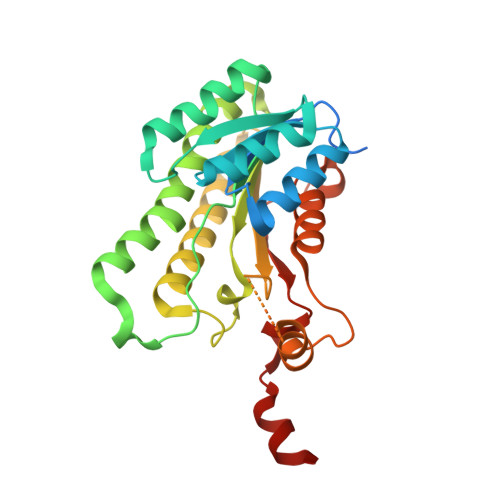A Structural View on the Stereospecificity of Plant Borneol-Type Dehydrogenases.
Chanique, A.M., Dimos, N., Drienovska, I., Calderini, E., Pantin, M.P., Helmer, C.P.O., Hofer, M., Sieber, V., Parra, L.P., Loll, B., Kourist, R.(2021) ChemCatChem 13: 2262-2277
- PubMed: 34262629
- DOI: https://doi.org/10.1002/cctc.202100110
- Primary Citation of Related Structures:
6ZYZ, 6ZZ0, 6ZZT - PubMed Abstract:
The development of sustainable processes for the valorization of byproducts and other waste streams remains an ongoing challenge in the field of catalysis. Racemic borneol, isoborneol and camphor are currently produced from α-pinene, a side product from the production of cellulose. The pure enantiomers of these monoterpenoids have numerous applications in cosmetics and act as reagents for asymmetric synthesis, making an enzymatic route for their separation into optically pure enantiomers a desirable goal. Known short-chain borneol-type dehydrogenases (BDHs) from plants and bacteria lack the required specificity, stability or activity for industrial utilization. Prompted by reports on the presence of pure (-)-borneol and (-)-camphor in essential oils from rosemary, we set out to investigate dehydrogenases from the genus Salvia and discovered a dehydrogenase with high specificity (E>120) and high specific activity (>0.02 U mg -1 ) for borneol and isoborneol. Compared to other specific dehydrogenases, the one reported here shows remarkably higher stability, which was exploited to obtain the first three-dimensional structure of an enantiospecific borneol-type short-chain dehydrogenase. This, together with docking studies, led to the identification of a hydrophobic pocket in the enzyme that plays a crucial role in the stereo discrimination of bornane-type monoterpenoids. The kinetic resolution of borneol and isoborneol can be easily integrated into the existing synthetic route from α-pinene to camphor thereby allowing the facile synthesis of optically pure monoterpenols from an abundant renewable source.
Organizational Affiliation:
Institute of Molecular Biotechnology Graz University of Technology Petersgasse 14 8010 Graz Austria.
















